Page 180 of 301
STARTING AND DRIVING
167
�
The shift position is displayed on the instrument
cluster.
P: Parking, engine starting and key removal position
R: Reverse position
N: Neutral position
D: Normal driving position (Shifting into overdrive
possible)
M: Position for manual shifting up or downshifting
When the cruise control is being used, even if you
downshift from ºDº to ºMº, engine braking will not be
enabled because the cruise control is not cancelled. For
the operation to decrease the vehicle speed, see page
179.
3, 2: Position for more powerful engine braking
L: Position for maximum engine braking Correct use of the automatic transmission is explained in
the following parts.
(a) Normal driving
(b) Driving in M mode
(c) Using engine braking
(d) Using the º3º, º2º and ºLº positions
(e) Backing up
(f) Parking
(g) Good driving practice
(h) Rocking your vehicle if stuck
(i) If you cannot shift the selector lever
(j) If the ºECT PWRº indicator light flashes
Page 181 of 301
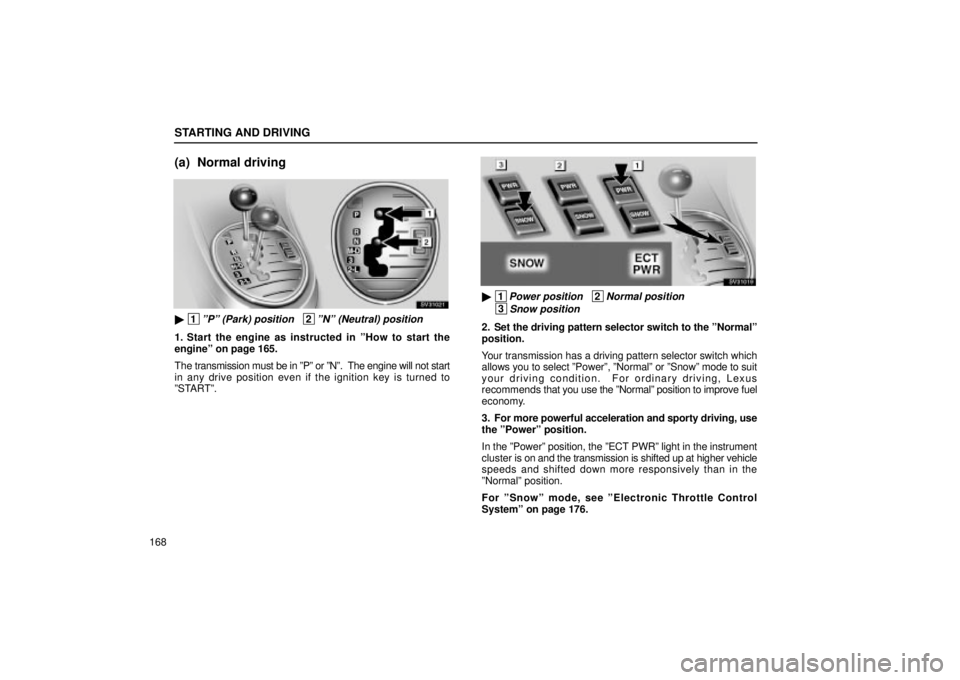
STARTING AND DRIVING
168
(a) Normal driving
SV31021
� 1ºPº (Park) position 2ºNº (Neutral) position
1. Start the engine as instructed in ºHow to start the
engineº on page 165.
The transmission must be in ºPº or ºNº. The engine will not start
in any drive position even if the ignition key is turned to
ºSTARTº.
SS31019
� 1Power position 2Normal position
3Snow position
2. Set the driving pattern selector switch to the ºNormalº
position.
Your transmission has a driving pattern selector switch which
allows you to select ºPowerº, ºNormalº or ºSnowº mode \
to suit
your driving condition. For ordinary driving, Lexus
recommends that you use the ºNormalº position to improve fuel
economy.
3. For more powerful acceleration and sporty driving, use
the ºPowerº position.
In the ºPowerº position, the ºECT PWRº light in the instrument\
cluster is on and the transmission is shifted up at higher vehicle
speeds and shifted down more responsively than in the
ºNormalº position.
For ºSnowº mode, see ºElectronic Throttle Control
Systemº on page 176.
Page 184 of 301
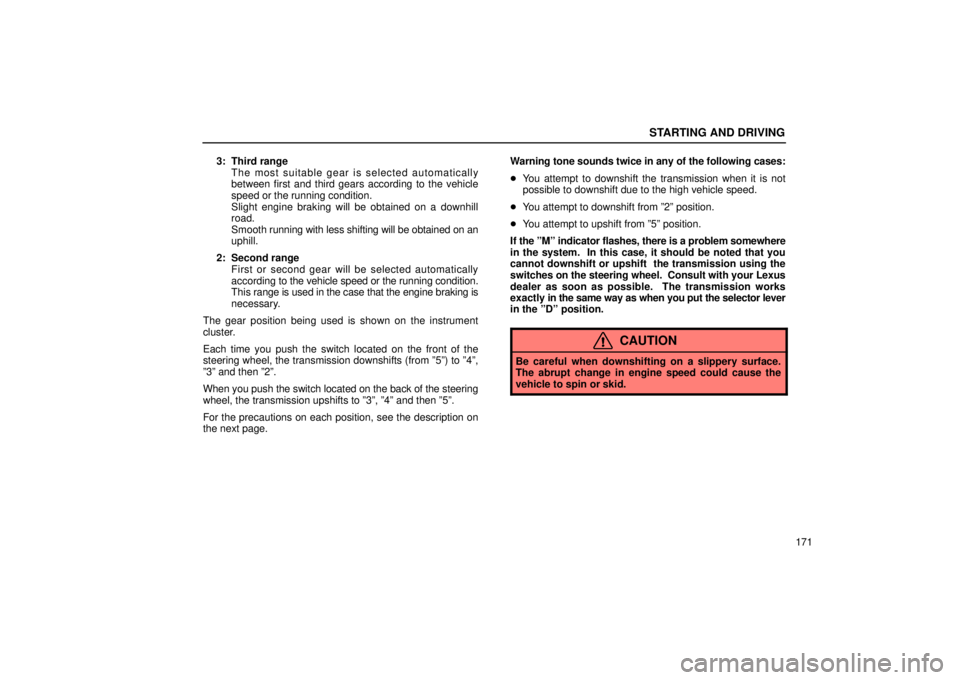
STARTING AND DRIVING
171
3: Third range
The most suitable gear is selected automatically
between first and third gears according to the vehicle
speed or the running condition.
Slight engine braking will be obtained on a downhill
road.
Smooth running with less shifting will be obtained on an
uphill.
2: Second range First or second gear will be selected automatically
according to the vehicle speed or the running condition.
This range is used in the case that the engine braking is
necessary.
The gear position being used is shown on the instrument
cluster.
Each time you push the switch located on the front of the
steering wheel, the transmission downshifts (from º5º) to º4º\
,
º3º and then º2º.
When you push the switch located on the back of the steering
wheel, the transmission upshifts to º3º, º4º and then º5º\
.
For the precautions on each position, see the description on
the next page. Warning tone sounds twice in any of the following cases:
�
You attempt to downshift the transmission when it is not
possible to downshift due to the high vehicle speed.
� You attempt to downshift from º2º position.
� You attempt to upshift from º5º position.
If the ºMº indicator flashes, there is a problem somewhere
in the system. In this case, it should be noted that you
cannot downshift or upshift the transmission using the
switches on the steering wheel. Consult with your Lexus
dealer as soon as possible. The transmission works
exactly in the same way as when you put the selector lever
in the ºDº position.
CAUTION
Be careful when downshifting on a slippery surface.
The abrupt change in engine speed could cause the
vehicle to spin or skid.
Page 188 of 301
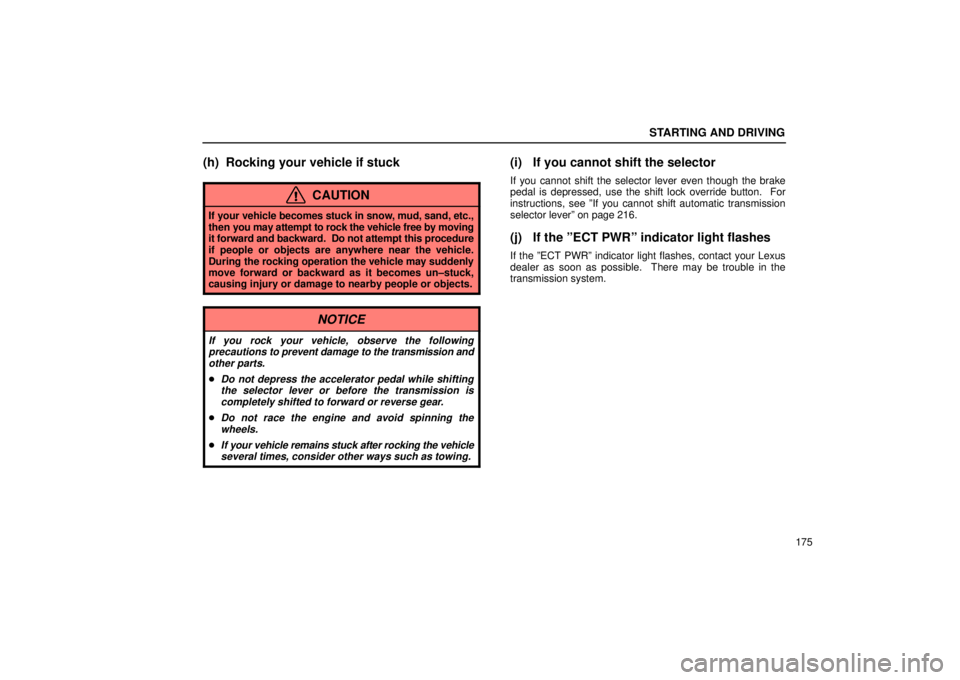
STARTING AND DRIVING
175
(h) Rocking your vehicle if stuck
CAUTION
If your vehicle becomes stuck in snow, mud, sand, etc.,
then you may attempt to rock the vehicle free by moving
it forward and backward. Do not attempt this procedure
if people or objects are anywhere near the vehicle.
During the rocking operation the vehicle may suddenly
move forward or backward as it becomes un±stuck,
causing injury or damage to nearby people or objects.
NOTICE
If you rock your vehicle, observe the following precautions to prevent damage to the transmission and
other parts.
�Do not depress the accelerator pedal while shifting the selector lever or before the transmission iscompletely shifted to forward or reverse gear.
�Do not race the engine and avoid spinning thewheels.
�If your vehicle remains stuck after rocking the vehicleseveral times, consider other ways such as towing.
(i) If you cannot shift the selector
If you cannot shift the selector lever even though the brake
pedal is depressed, use the shift lock override button. For
instructions, see ºIf you cannot shift automatic transmission
selector leverº on page 216.
(j) If the ºECT PWRº indicator light flashes
If the ºECT PWRº indicator light flashes, contact your Lexus
dealer as soon as possible. There may be trouble in the
transmission system.
Page 189 of 301
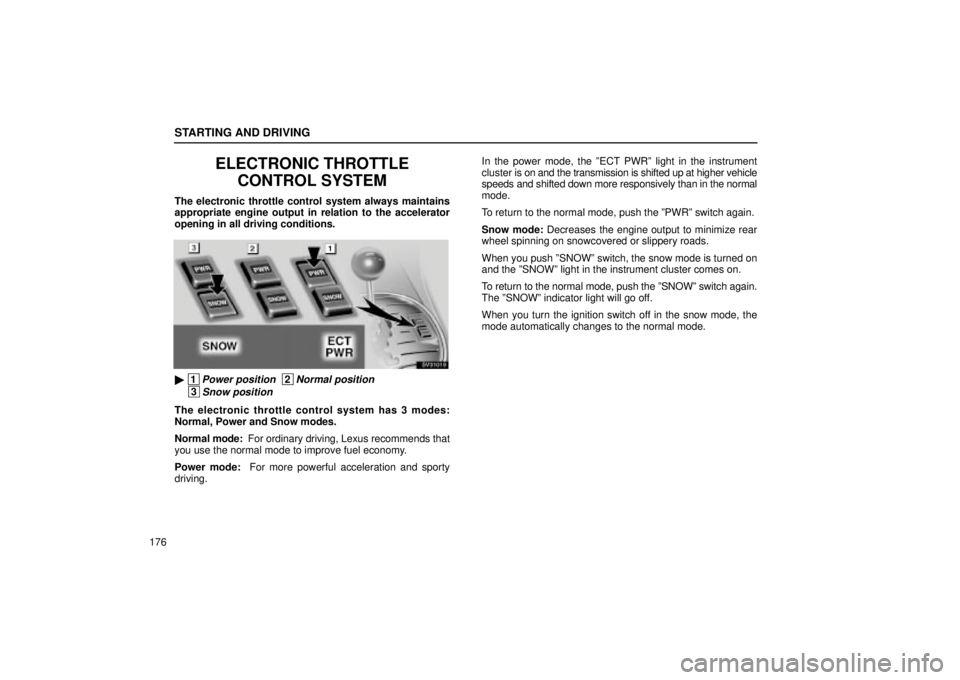
STARTING AND DRIVING
176
ELECTRONIC THROTTLECONTROL SYSTEM
The electronic throttle control system always maintains
appropriate engine output in relation to the accelerator
opening in all driving conditions.
SV31019
� 1Power position 2Normal position
3Snow position
The electronic throttle control system has 3 modes:
Normal, Power and Snow modes.
Normal mode: For ordinary driving, Lexus recommends that
you use the normal mode to improve fuel economy.
Power mode: For more powerful acceleration and sporty
driving. In the power mode, the ºECT PWRº light in the instrument
cluster is on and the transmission is shifted up at higher vehicle
speeds and shifted down more responsively than in the normal
mode.
To return to the normal mode, push the ºPWRº switch again.
Snow mode: Decreases the engine output to minimize rear
wheel spinning on snowcovered or slippery roads.
When you push ºSNOWº switch, the snow mode is turned on
and the ºSNOWº light in the instrument cluster comes on.
To return to the normal mode, push the ºSNOWº switch again.
The ºSNOWº indicator light will go off.
When you turn the ignition switch off in the snow mode, the
mode automatically changes to the normal mode.
Page 190 of 301
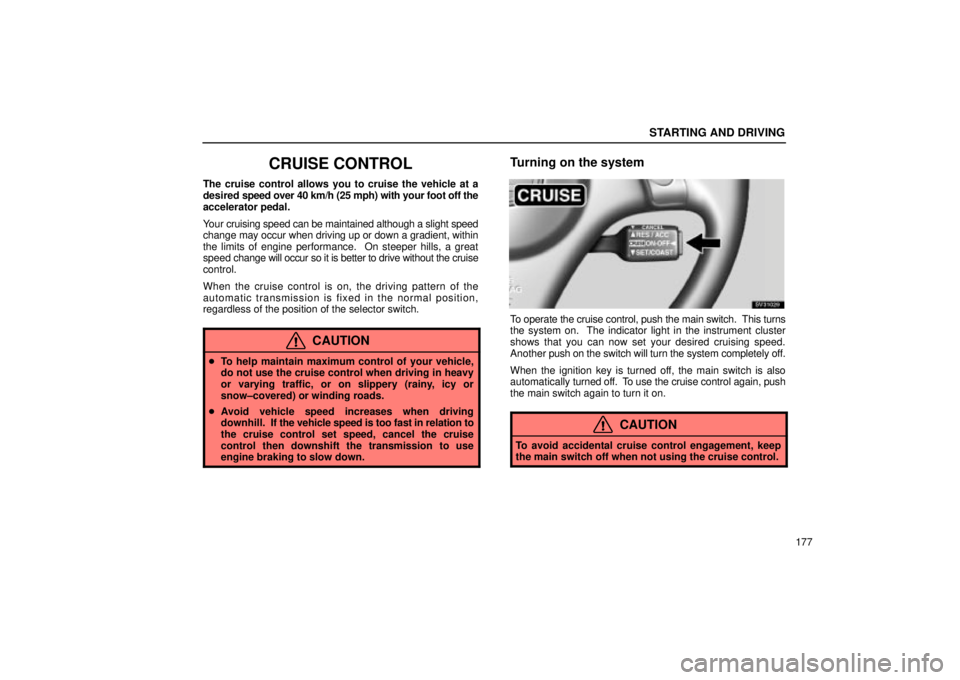
STARTING AND DRIVING
177
CRUISE CONTROL
The cruise control allows you to cruise the vehicle at a
desired speed over 40 km/h (25 mph) with your foot off the
accelerator pedal.
Your cruising speed can be maintained although a slight speed
change may occur when driving up or down a gradient, within
the limits of engine performance. On steeper hills, a great
speed change will occur so it is better to drive without the cruise
control.
When the cruise control is on, the driving pattern of the
automatic transmission is fixed in the normal position,
regardless of the position of the selector switch.
CAUTION
� To help maintain maximum control of your vehicle,
do not use the cruise control when driving in heavy
or varying traffic, or on slippery (rainy, icy or
snow±covered) or winding roads.
� Avoid vehicle speed increases when driving
downhill. If the vehicle speed is too fast in relation to
the cruise control set speed, cancel the cruise
control then downshift the transmission to use
engine braking to slow down.
Turning on the system
SV31029
To operate the cruise control, push the main switch. This turns
the system on. The indicator light in the instrument cluster
shows that you can now set your desired cruising speed.
Another push on the switch will turn the system completely off.
When the ignition key is turned off, the main switch is also
automatically turned off. To use the cruise control again, push
the main switch again to turn it on.
CAUTION
To avoid accidental cruise control engagement, keep
the main switch off when not using the cruise control.
Page 192 of 301

STARTING AND DRIVING
179
4Resetting to a slower speed
Press the control lever downward in the ºSET/COASTº
direction and hold it. Release the lever when the desired
speed is attained. While the lever is held downward, the
vehicle speed will gradually decrease.
When the difference between the actual vehicle speed and the
set speed is less than 5 km/h (3 mph), the set speed can be
lowered 1.6 km/h (1 mph) each time by pressing the control
lever downward in the ºSET/COASTº direction quickly within
0.6 seconds.
However, a quicker way to reset is to depress the brake pedal
and then press the control lever downward in the
ºSET/COASTº direction.
Even if you downshift the transmission from the ºDº position to
ºMº with the cruise control on, engine braking will not be
applied because the cruise control is not cancelled. To
decrease the vehicle speed, reset to a slower speed with the
cruise control lever or depress the brake pedal. If you use the
brake pedal, cruise control is cancelled.
5 Resuming the preset speed
If the preset speed is cancelled by pulling the control lever or
by depressing the brake pedal, pushing the lever up in the
ºRES/ACCº direction will restore the speed set prior to
cancellation. However, once the vehicle speed falls below
about 40 km/h (25 mph), the preset speed will not be resumed.
Cruise control failure warning
If the ºCRUISEº indicator light in the instrument cluster flashes
five times and then goes out when using the cruise control, it
means that there is trouble in the cruise control system.
Contact your Lexus dealer.
Page 193 of 301

STARTING AND DRIVING
180
TRACTION CONTROL SYSTEM
The traction control system automatically help control the
spinning of the rear wheels which may occur when
accelerating on slippery road surfaces, thus assisting
driver control the driving power of the rear wheels. When
you turn the ignition switch on, the traction control
system always turns on automatically, and the slip
indicator light w ill come on. The indicator lights will go off
after a few seconds.
SV31011
� 1Slip indicator light
2ºSNOWº indicator light
Leave the system on during ordinary driving so that it can
operate when needed. When traction control is applied,
the slip indicator light blinks. If your vehicle still skids
even though traction control is applied, more powerful
traction control is applied and the ºSNOWº indicator light
comes on. If the light flashes, this indicates a malfunction in the traction
control system. Contact your Lexus dealer as soon as
possible to service the vehicle.
SV31018
You can turn off the traction control system by pushing
the ºTRAC OFFº switch. The ºTRAC OFFº
indicator/warning light will then come on. Pushing the
ºTRAC OFFº switch a second time turns the system back
on and extinguishes the ºTRAC OFFº indicator/warning
light.
You may hear a sound in the engine compartment for a few
seconds when the engine is started or just after the vehicle is
started. This means that the traction control system is in the
self±check mode, and does not indicate malfunction.
When the traction control system is operating, you may feel
vibration of your vehicle, caused by operation of the brakes.
This indicates the system is functioning properly.